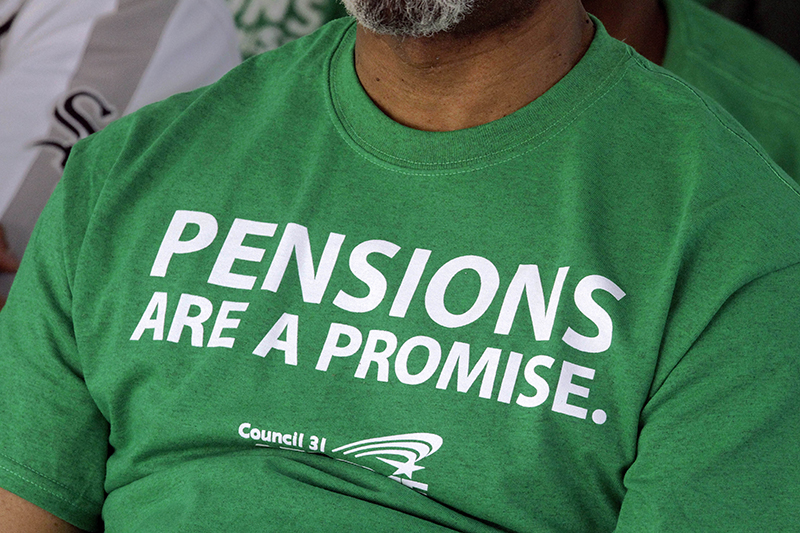The recent shutdown of the federal government showed how fragile the savings rate is in America. Stories of furloughed workers pawning their wedding rings, staying home from work because they couldn’t afford child care and going to payday lenders are a devastating indictment of the vulnerable situation many Americans, even those with a steady paycheck, find themselves in.
Half of Americans don’t have anything saved. We want to change that. Our mission to ensure that all Americans can retire and live out their lives without fear of destitution has been embraced in many surprising ways. In this time of stark divisions, more than three-quarters of both Republicans and Democrats support the concept of a guaranteed retirement account (GRA) — an account into which employers and employees make modest, regular deposits that grow into a reliable nest egg.
Indeed, according to Gallup, retirement has been the No. 1 issue on Americans’ minds since 2000 — a greater concern than economic insecurity or even health care. In fact, one survey found that 80 percent of Americans fear retirement more than they fear death itself.
The strongest support for GRAs comes from young people. The retirement system that was built for the 20th century is not working for them. Many are mired in student debt or work in the gig economy. Their grandparents who had pensions could retire, but their parents can’t afford to, and young people worry that will be their fate, too.
Some people argue that education is the key to retirement security — that if Americans only knew more about saving for retirement, they would build adequate nest eggs. Of course, Americans should know not to overspend and should understand credit card debt, car payments and mortgages. But it’s unrealistic to expect most people to know how to allocate equities, diversify holdings and assess economic conditions. And our members who have pensions generally have been satisfied to have professional trustees and advisers do that work for them.
The fact is that small and midsize businesses and their employees need help. The vast majority don’t provide retirement vehicles because they are expensive, confusing and include fiduciary liability. Unlike those who work for the government or large employers, these employees don’t have the option to have a retirement plan at work.
GRAs provide a simple solution: The money in the accounts belongs to the employee — neither the employer nor the government can take it, and it cannot be shared with other workers. Workers who already have a pension plan keep it. GRAs are portable from job to job. The accounts would be invested by private, professional money managers. Workers decide when to retire and convert their savings into a guaranteed monthly payment for the rest of their lives, based on the size of their account at the time of retirement. Upon death, the account will be transferred to a beneficiary of the worker’s choosing.
Too good to be true? Not at all. Elements of this plan have been tested in a variety of countries, including Australia.
One example of simple and easy retirement savings similar to GRAs is in Oregon, which encouraged businesses that did not offer a retirement plan to offer an opt-out savings option to all employees. So far, more than two-thirds of employees have opted in. They were not “more educated,” they just had an easier way to save. And studies show that many of those who did not opt in already had a retirement plan.
New York City is another example: Mayor Bill de Blasio plans to create a city-managed retirement fund for workers who lack access to employer-sponsored plans.
These plans are especially important for women and people of color. The persistent racial wealth gap during African-Americans’ and Latinos’ working years follows them into their retirements. An Urban Institute report found that, in 2013, the average white family had more than $130,000 in liquid retirement savings, compared with $19,000 for the average African-American family and $12,000 for the average Hispanic family. Women are much more likely than men to face poverty in retirement — they generally live longer, have lower earnings and are more likely to outlive sources of retirement income. We must expand and strengthen Social Security, coupled with guaranteed retirement accounts, which can help break this cycle of economic struggle by ensuring that all Americans have the ability to save for retirement in a simple, cost-effective way.
Ensuring every American’s final years are secure is a moral — and attainable — imperative.
Kathleen Kennedy Townsend is director of retirement security at EPI, serves on the board of Maryland Saves and was Maryland’s first woman lieutenant governor. Randi Weingarten is the president of the American Federation of Teachers. They wrote this for The Baltimore Sun, where it first appeared. They can be reached at: aftpress@aft.org
©2019 The Baltimore Sun
Visit The Baltimore Sun at www.baltimoresun.com
Distributed by Tribune Content Agency, LLC.
Send questions/comments to the editors.



Success. Please wait for the page to reload. If the page does not reload within 5 seconds, please refresh the page.
Enter your email and password to access comments.
Hi, to comment on stories you must . This profile is in addition to your subscription and website login.
Already have a commenting profile? .
Invalid username/password.
Please check your email to confirm and complete your registration.
Only subscribers are eligible to post comments. Please subscribe or login first for digital access. Here’s why.
Use the form below to reset your password. When you've submitted your account email, we will send an email with a reset code.